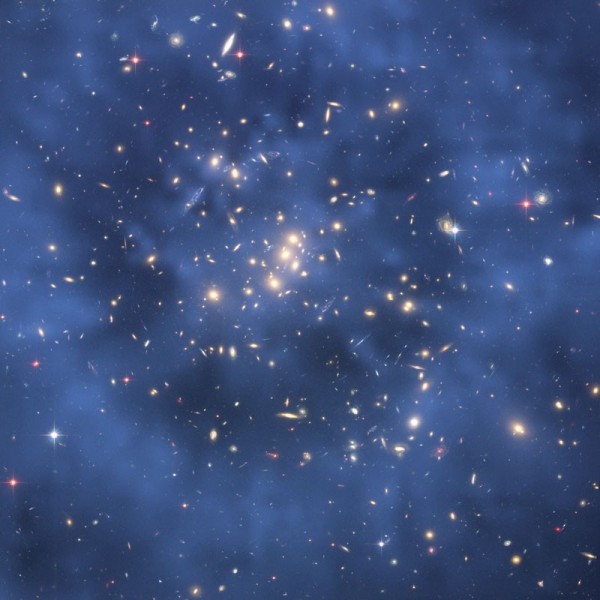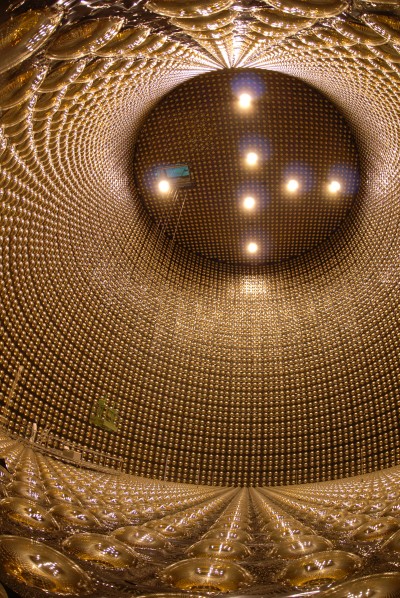
|
Main Topics > The Big Bang and the Big Crunch > Dark MatterThe simple Big Bang theory is, however, not without its potential problems, and some aspects require further investigation and explanation. One such problem is the rather unfortunate fact that about 85-85% of the matter which is predicted to exist in the universe appears to be invisible or otherwise unaccounted for! The evenness of the cosmic microwave background radiation (the afterglow of the initial Big Bang) suggests that the matter emitted from the Big Bang should have been spread around very smoothly. But we know that the universe is in fact clumpy, with clusters of galaxies and great voids of empty space in between. Actually, in 1992, NASA’s Cosmic Background Explorer (COBE) satellite did discover some variations or ripples in the brightness of the afterglow, which probably resulted from a period about 450,000 years after the Big Bang, when some parts of the universe became just a few thousandths of a percent denser than others. These barely noticeable clumps of matter grew to become bigger clumps due to the cumulative effects of gravity, and the denser regions (the “seeds” of structure) became ever denser over time, leading to the great clusters of galaxies we see today. However, the modelling of this theory revealed that the 13.7 billion years which has elapsed since the Big Bang is actually nowhere near long enough for the huge structures of today’s universe to have developed, by the gradual process of gravity and increasing density, out of the tiny imperfections and clumps indicated by the COBE satellite. This could only have happened if there was, and/or is, much more matter in the universe than our current estimates of the matter tied up invisible stars. This has led to speculation about so-called "dark matter", an unknown substance which emits no light, heat, radio waves, nor any other kind of radiation (thus making extremely hard to detect).
The idea of dark matter, though, goes back much further than that. The stars in spiral galaxies like our own Milky Way whirl about the galactic center, prevented from flying off into intergalactic space by gravity. However, calculations of the speed of the whirling, dating back to work by maverick astronomer Fritz Zwicky in the 1930s, suggest that the galaxy is actually spinning much faster than it theoretically should be in order to maintain its current equilibrium. Zwicky hypothesized that the only way this could occur was if galaxies, ours and all the others, actually contained much more matter (he estimated at least ten times as much) as is visible in stars, spread reasonably evenly throughout the galaxy. Zwicky's observations were backed up by more accurate data gathered by Vera Rubin in the 1960s, and by Jim Peebles and Jerry Ostricker in the 1970s. Rubin noted that stars right out near the edge of the galaxy were orbiting around the galactic center at the same speed as stars much closer in, whereas in our solar system, for example, the innermost planets orbit much faster than those further out. (Other more recent studies have shown that even hydrogen gas out on the fringes of the galaxy is still orbiting just as fast as the inner stars). It therefore appeared as though the force of gravity did NOT get weaker the further a star was from the center of the galaxy, which flew in the face of all that was known about gravity. The only explanation was that some unseen and undetected mass (i.e. dark matter) was causing the increased rotation. Thus, it appears that around 85% of the mass making up galaxies must be composed of an unknown, invisible substance which came to be known as dark matter. This is almost exactly the factor of additional matter required by the models to allow the structures we see in today’s universe to have developed from the ripples in the cosmic microwave background radiation discovered by the COBE satellite, as mentioned above. This dark matter makes up an even greater proportion of the small dwarf galaxies that can be found orbiting larger galaxies, including our own, and the same thing also applies on a larger scale to entire clusters of galaxies, millions of light years across, which would also need to contain many more times more material than we can see in order to hold together. More recent studies, using modern gravitational lensing techniques, have added further confirmations, if any were needed, and have allowed the creation of a kind of "map" of dark matter which shows how galaxies and clusters of stars tend to form around, and within, the largest blobs of dark matter, which forms a kind of all-pervading halo around the visible objects of the universe. In this way, Carlos Frenk has produced a dramatic 3D simulation of the dark matter throughout the whole visible universe, showing what he calls the "skeleton" of the universe, or the "scaffolding" around which galaxies and clusters of galaxies have formed. It seems that everything we know is ultimately dependent on dark matter - without dark matter there would be no galaxies; without galaxies there would be no stars; without stars there would be no planets, and therefore no life. The problem is that dark matter, whatever it may be, is invisible and extremely hard to detect. It is affected by gravity, but not by any of the other fundamental forces; it has no electrical charge; it does not seem to stick or clump together but floats freely; and it passes through atoms of normal matter without any kind of interference we can detect. In fact, it appears not even to interact with itself: colliding galaxies have been observed, where the normal matter of the two galaxies re-coalesces together as expected, but the dark matter just keep on going along its original path regardless. Its existence and properties can only be inferred from its gravitational effects on visible matter, radiation, and the large-scale structure of the universe. So, despite its apparent ubiquity, no-one really knows what dark matter is, and astronomers are using a variety of technique, including gravitational lensing, to try to spot where such matter might lie. Among the possible candidates are so-called MACHOs (short for MAssive Compact Halo Objects), such as small brown and black dwarf stars, cold unattached planets, comet-like lumps of frozen hydrogen, tiny black holes, possibly even mini dark galaxies. Other candidates for baryonic dark matter include cold and warm gas, bound to galaxy groups, but too cool to be visible or even detectable.
Scientists are also investigating other kinds of non-baryonic exotic particles, including WIMPs (short for Weakly Interacting Massive Particles), hypothetical super-symmetrical particles which may be all around us but which pass through normal matter without stopping and without interacting in any way. Experiments to look for WIMPs are being carried out in highly-shielded, super-cooled facilities deep down in rocky mines where other interfering cosmic rays cannot penetrate. Another category of non-baryonic exotic particle, neutrinos, may represent another possibility. Neutrinos are tiny elementary particles which have no electric charge, hardly interact at all with ordinary atoms, and travel at a speed consistent with the speed of light (CERN, 2012). It is hypothesized that they could have come into existence during the first second after the Big Bang as part of the reaction with the photons that were created at that time, and it is calculated that there could be hundreds of millions of them for every atom in the universe, with millions of them passing through you and I and everything around us every second. So, even if each neutrino weighed a hundred-millionth as much as an atom, they could theoretically still be the dominant, if unseen, matter in the universe.
|
Back to Top of Page
Introduction | Main Topics | Important Dates and Discoveries | Important Scientists | Cosmological Theories | The Universe By Numbers | Glossary of Terms | Blog | A Few Random Facts | Angular Momentum Calculator | Big Bang Timeline
The articles on this site are © 2009-.
If you quote this material please be courteous and provide a link.
Citations | Sources | Privacy Policy

